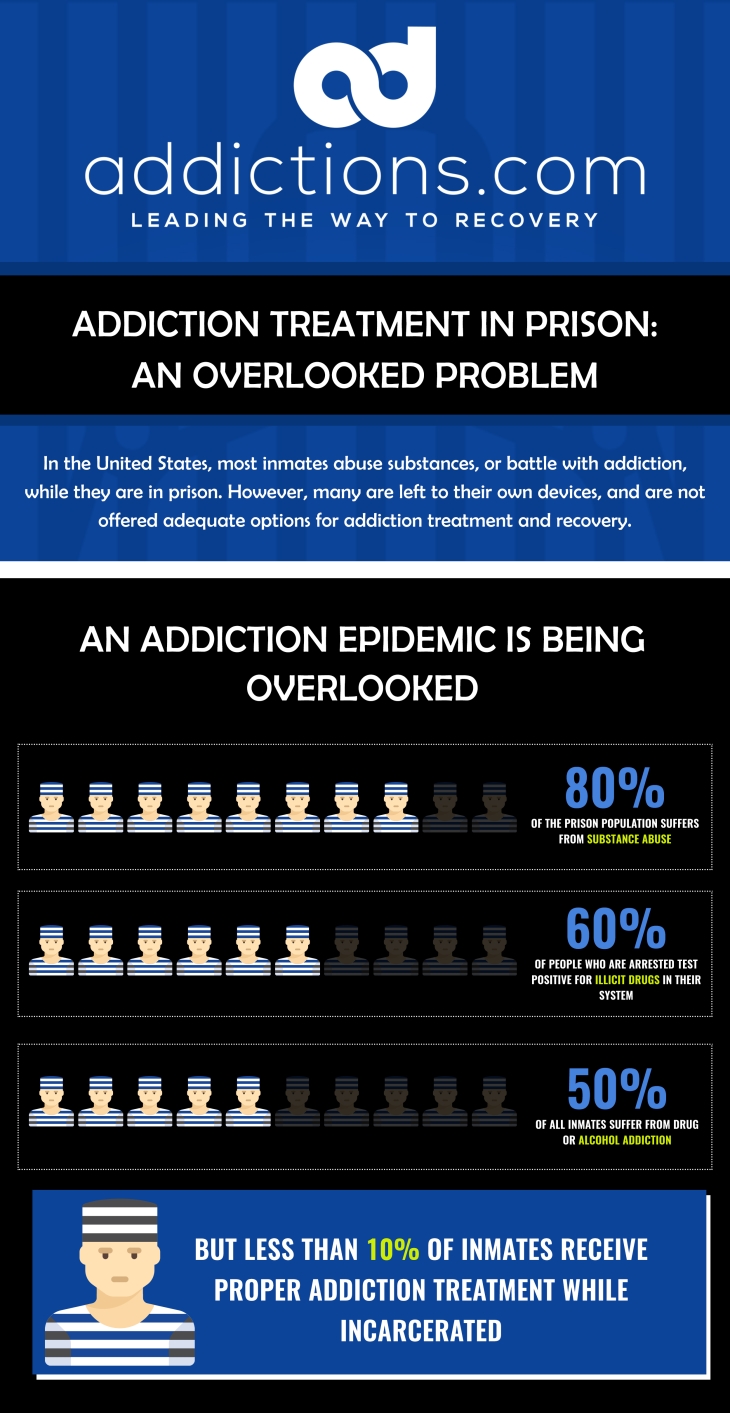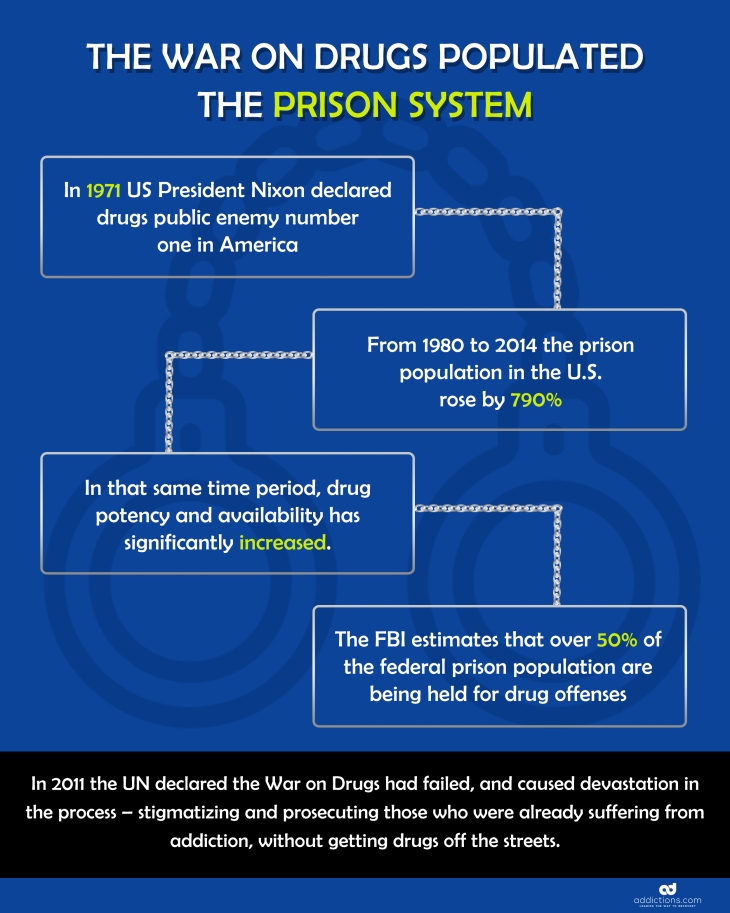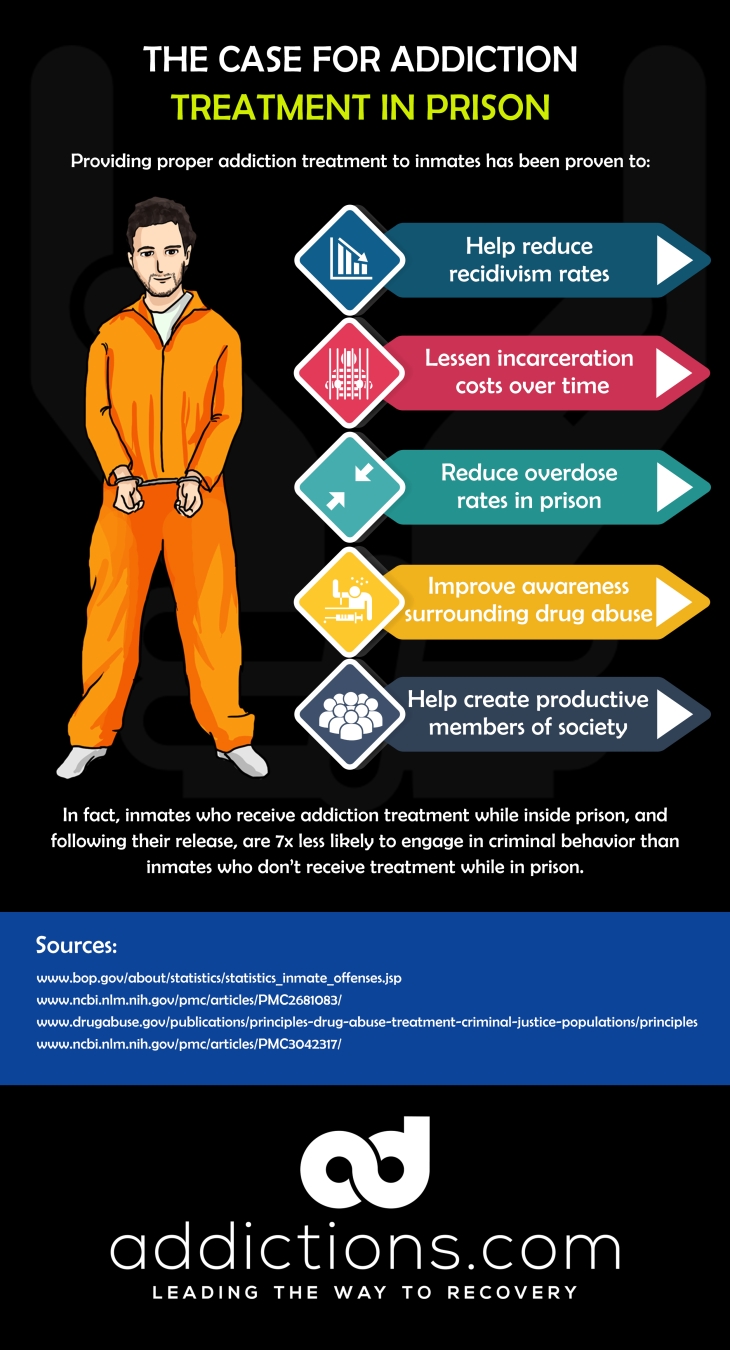Did you know that 80 percent of the American prison population abuses drugs or alcohol? Statistics show that roughly 60 percent of people arrested for most crimes test positive for illicit drugs at the time of arrest, and that 50 percent of all prison and jail inmates suffer from chemical dependency and addiction. But despite these shockingly high statistics, only a very small percentage of these individuals receive addiction treatment while incarcerated.
A 2010 report from Columbus University reveals that only 10 percent of inmates who suffer from addiction are provided with treatment during their sentences. This means that those who lack access to treatment and suffer severe addictions to substances like heroin, fentanyl, and alcohol are at risk for serious health complications and death caused by withdrawal symptoms. Furthermore, these individuals are more likely to return to abusing drugs and alcohol upon release from prison, and remain stuck in a life-destructing cycle of crime and addiction.
Research shows that providing inmates with addiction treatment in prison can greatly reduce recidivism and overall crime rates, and lessen the impact of incarceration costs on the economy. Increasing access to drug treatment in prison can also teach inmates how to repair and rebuild their lives, improve their physical and psychological health, and handle important responsibilities in the outside world without turning to drugs and alcohol at moments of stress.
Here’s an overview of how addiction is handled in U.S. correctional facilities, and how increasing access to addiction treatment in prison can improve the country and save the lives of those incarcerated for crimes committed in the name of this chronic disease.
The War on Drugs, and Its Effect on the Prison Population
The U.S. federal prison population rose by a whopping 790 percent from 1980 to 2014 — largely due in part to the War on Drugs. Today, American prisons are consistently overcrowded, and endangering the lives of both inmates and correction officers on behalf of this government-led initiative to stop illicit drug use and distribution.
The Federal Bureau of Prisons reports that almost 50 percent of inmates are in federal prison for drug offenses. When combined with the percentage of immigration-related crimes, nonviolent crimes involving drugs or immigration make up nearly 55 percent of the entire country’s prison population. If sentences revolving around drug offenses were eliminated or shortened, the U.S. would spend billions less on costs associated with incarceration.
Many consider the War on Drugs a failure in regards to eliminating and controlling drug abuse in the U.S. — especially since data shows that today’s illicit drugs are cheaper, deadlier, and more potent than ever. Drug use rates have also increased significantly in recent years, with global use of opioids and cocaine rising by 35 percent and 27 percent respectively from 1998 to 2008.
The War on Drugs focuses on treating addiction as a crime, when in fact, addiction is a medical disorder in the form of a chronic relapsing brain disease. Failing to offer addiction treatment in prison only further contributes to rising addiction rates, overcrowded prisons, and compromised public safety.
What Options Do Addicted Inmates Currently Have?
Drug education is the most commonly available service offered to inmates who suffer from addiction, but this service is just one component of many that make up formal addiction treatment. Those who suffer from addiction need physical and psychological therapies like detoxification and counseling to overcome addiction as a whole. More than 25 percent of state inmates and one in five federal inmates receive support group therapy but this therapy alone is rarely effective at helping individuals completely overcome addiction.
Research shows that less than 10 percent of inmates nationwide have access to addiction treatment services while in prison on behalf of factors such as inexperienced medical staff and lack of resources. Many times, medical staff lack education surrounding substance abuse and addiction, while correctional facilities lack funding for medications and therapies proven useful at treating addiction. Though drug treatment in prison may be offered at a minimal level, the National Institute of Drug Abuse suggests that facilities use 13 principles to properly address addiction in the criminal justice system. Prisons and treatment providers are to use these principles to help inmates get clean and teach them how to stay sober and avoid relapse following release.
These principles include raising awareness surrounding the fact that drug addiction is a brain disease that affects behavior, and that treatment must be consistent and ongoing to produce stable results and behavioral changes. The principles also suggest that addiction treatments be tailored to each individual inmate based on their unique struggle with drug abuse, and should target factors commonly associated with criminal behavior. As a whole, these principles are intended to reduce recidivism rates and improve inmates’ overall quality of life after overcoming addiction and leaving prison.
How Does Drug Treatment in Prison Improve Public Safety?
Since addiction is a chronic relapsing brain disease, this condition cannot go away on its own without proper treatment. Addiction treatment in prison is often overlooked on behalf of the stigma surrounding addiction — many assume that inmates will learn from their mistakes while behind bars, and after having suffered painful and life-threatening withdrawal symptoms. But research shows that individuals are more likely to relapse later down the road without addiction treatment — especially inmates who return to their former lives upon release from prison.
A review of recidivism rates across 15 states revealed that 25 percent of inmates released from prison were sent back to prison within three years — many of whom tested positive for drug use at the time of arrest. But research shows that inmates who receive addiction treatment while in prison and following their release are seven times more likely to remain drug-free, and three times less likely to engage in criminal behavior than inmates who do not receive addiction treatment.
Participating in prison addiction treatment allows inmates to overcome this brain disorder that may have led to their incarceration in the first place. Inmates can first overcome chemical dependency so they no longer crave or physically rely on drugs and alcohol to function normally. Next, inmates can benefit from therapies like behavioral counseling and relapse prevention education to overcome co-occurring disorders driving their addiction, and to learn the skills needed to stay sober for life after leaving prison.
Addiction treatment helps former inmates re-enter society and rebuild their lives without being distracted by drugs and alcohol. These individuals often face higher success rates in terms of employment, and no longer have to suffer health problems and poor memory brought on by substance abuse. As these former inmates navigate society drug-free and without impulses to commit crimes that fuel an addiction, families and communities nationwide can benefit from improved public safety.
Treating Heroin and Painkiller Addiction in Prison
As the U.S. continues to fight its nationwide opioid epidemic outside prison walls, a high number of inmates are suffering severe cases of heroin and painkiller withdrawal behind bars — some of which have resulted in death. While heroin and painkiller withdrawal symptoms are generally not known to be life-threatening, there were four cases of jail deaths in 2015 caused by opioid withdrawal symptoms. One of those inmates died in jail before they were able to see the judge regarding the crime for which they had been arrested.
Opioid addiction in prison is commonly treated using methadone or buprenorphine — medications that help individuals safely and fully overcome heroin and painkiller dependence without suffering withdrawal symptoms. However, a recent study reveals that only 50 percent of all state and federal prisons offer medication-assisted treatment, and only under limited circumstances. For instance, some prisons only offer these treatments to pregnant women, or to those also suffering chronic pain from confirmed medical conditions.
When questioned about why opioid addiction treatments are so limited, jails and prisons claim that methadone and buprenorphine raise a number of security concerns, and that they prefer allowing inmates to detox naturally without the use of medications. Shockingly, 50 percent of prison medical directors are unaware of the benefits of treating opioid addiction using buprenorphine, while 27 percent claim being unaware of the benefits of methadone maintenance therapy.
A controlled medical trial conducted at Rikers Island jail in New York showed that inmates treated with buprenorphine are more likely to stick with addiction treatment throughout incarceration, and produce higher attendance rates at continuing care programs after their release. Another study shows that inmates who receive methadone and counseling in prison are more likely to stay clean one year following release than inmates who only receive counseling. Evidence backs up the efficacy of opioid addiction treatment and its role in helping former inmates stay clean and avoiding relapse following their prison sentences.
How Should Prisons Handle Drug Addiction?
At present, the U.S. government spends over 95 percent of funds allocated for substance abuse and addiction on the consequences brought on by drug abuse, such as hospitalization and incarceration. The remaining percentage of funds are spent on addiction prevention and treatment — meaning the country is wasting billions by being reactive instead of proactive in regards to addressing the nation’s drug problem. Data shows that the U.S. can earn over $90,000 per year for every inmate who receives addiction treatment, which would otherwise be spent on unemployment, incarceration, and related costs driven by lack of drug treatment in prison.
Based on the NDA’s principles of drug abuse treatments for prison systems, the most effective ways to treat addiction involve evaluating inmates for underlying mental health disorders, and offering consistent treatment from trained medical staff who can administer medication-assisted therapies. Additionally, correctional facilities can implement long-term programs that involve supporting inmates in their communities following release from prison.
While these solutions may seem costly for state and federal governments, the benefits far outweigh any cons. Today, the addiction treatments available across prisons vary depending on the facility and its resources. A study conducted by the National Center on Addiction and Substance Abuse found that only 65 percent of correctional facilities offer individual or group counseling in the form of cognitive-behavioral therapy, behavioral counseling, and similar therapies. Self-help groups such as Alcoholics Anonymous and Narcotics Anonymous are available at 74 percent of prisons, and serve as useful interventions that encourage a supportive environment among those in recovery.
What Steps Can You Take to Help?
Many times, addiction begins at home, and can be triggered by a wide range of risk factors including family genetics, environment, and mental health disorders. Addressing substance abuse and addiction at its earliest stages allows you and your loved ones to stay in control of your lives, and avoid turning to crime and unlawful behavior for the sake of obtaining and using drugs and alcohol. Familiarize yourself with common signs of addiction, and intervene at the right time so your loved one can receive addiction treatment as needed.
Americans can acknowledge and address the stigma surrounding addiction and former inmates, and help communities understand that addiction is a brain disease, and not a form of criminal behavior. Drugs can alter the way the brain functions, and influence its victims to continue using drugs and alcohol despite negative consequences. Many times, those who suffer from addiction commit crimes so they can afford and obtain drugs, and so they can avoid experiencing severe withdrawal symptoms associated with drug abuse.
The presence of mental health disorders can also increase one’s risk for addiction. Individuals who suffer from depression, bipolar disorder, and anxiety disorders like OCD may use drugs and alcohol to self-medicate and avoid symptoms associated with their disorders. If a friend or loved one suffers a mental health disorder, look for signs that may indicate drug abuse so your loved one can be treated for both conditions at a nearby drug rehab center.



